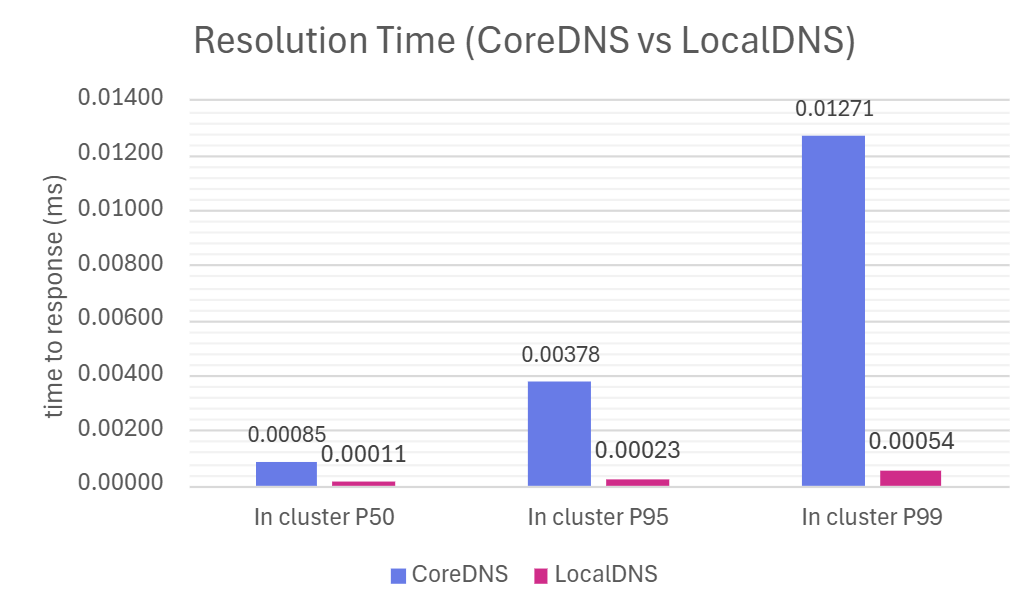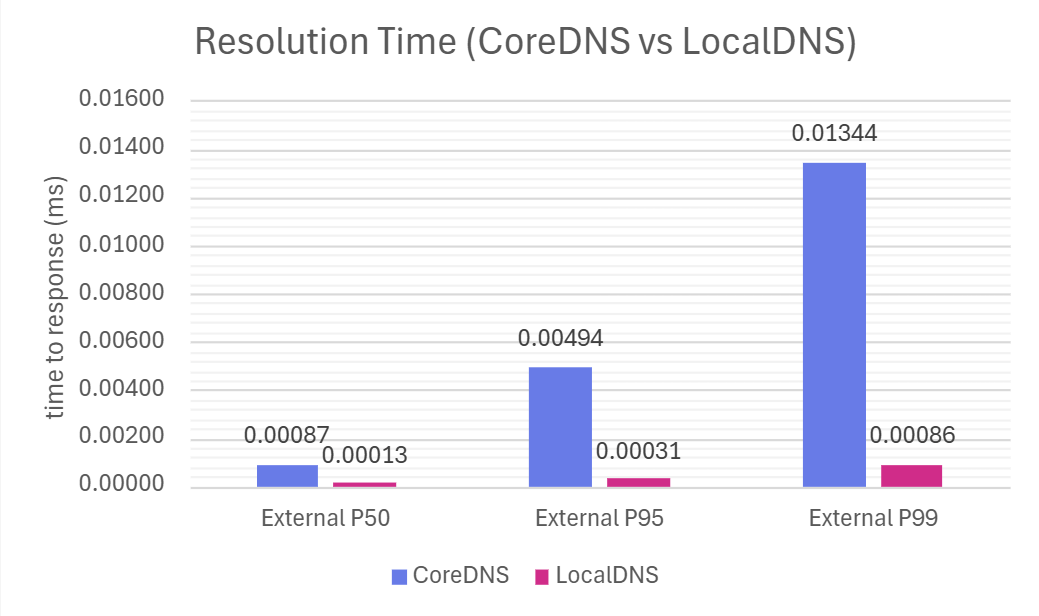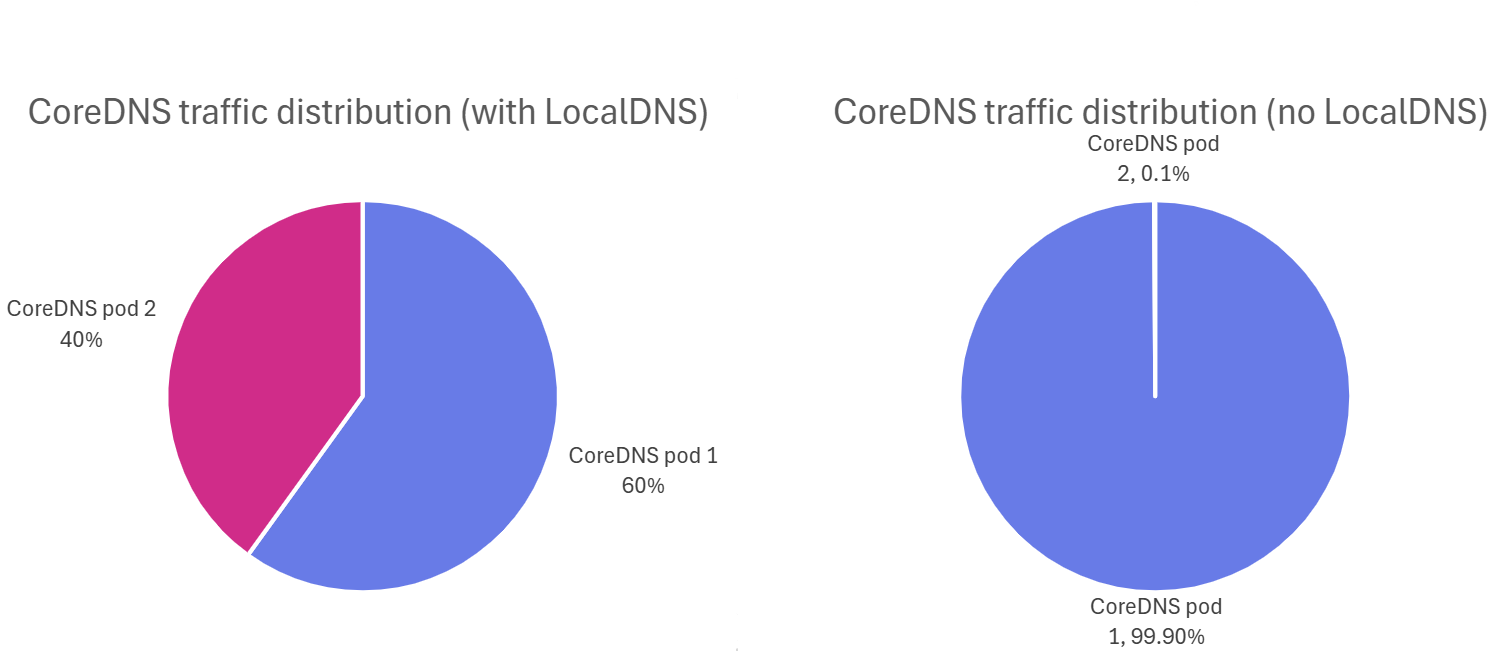Accelerate DNS Performance with LocalDNS
DNS performance issues can cripple production Kubernetes clusters, causing application timeouts and service outages. LocalDNS in AKS solves this by moving DNS resolution directly to each node, delivering 10x faster queries and improved reliability. In this post, we share the results from our internal tests showing exactly how much of an improvement LocalDNS can make and how it can benefit your cluster.
Background: The Hidden Cost of DNS in Production Kubernetes
In Kubernetes clusters, DNS is the invisible backbone that enables service discovery and inter pod communication, but its critical role often goes unnoticed until it becomes a bottleneck. DNS related issues are among the most challenging operational problems. What begins as minor performance degradation can quickly escalate into customer impacting incidents and even full scale outages. As cluster size grows, the complexity of DNS management increases exponentially. A configuration that works for a small development environment may prove completely inadequate at production scale, exposing fundamental architectural limitations that can threaten the reliability and scalability of the entire system.
Why Centralized CoreDNS Becomes a Bottleneck in Kubernetes Clusters
Traditional DNS was built for static, predictable environments with long lived hosts and low query volumes. Kubernetes, however, is dynamic and high churn:
- Ephemeral workloads: Pods are rapidly created and destroyed, each needing immediate DNS resolution
- High query volume: Service meshes, health checks, and inter service calls generate thousands of DNS queries per second
- Dynamic endpoints: Services and pods frequently change IPs, requiring constant DNS updates and cache invalidation
- Complex networking: Multiple network layers (pod, service, ingress) add latency and increase DNS infrastructure load
These differences turn DNS from a background service into a critical bottleneck as clusters grow. Relying on a handful of centralized CoreDNS pods exposes architectural weaknesses: all DNS queries are funneled through these pods, creating a single point of contention and introducing network overhead with every lookup. High query volumes can overwhelm conntrack tables, and centralized caching misses the benefits of local cache hits—forcing even repeated queries to traverse the network.
The result? Application timeouts, resource exhaustion, cascading failures, and increased operational burden. Without rethinking DNS architecture, teams face increased latency, reliability issues, and operational headaches at scale. LocalDNS addresses these challenges by decentralizing DNS resolution—moving the cache and resolver directly onto each node, closer to every workload.
Introducing LocalDNS for Faster, More Reliable DNS Resolution
To address these fundamental architectural challenges, AKS introduces LocalDNS - a node level DNS proxy that transforms how DNS resolution works in Kubernetes clusters. LocalDNS represents a shift from centralized DNS resolution to a distributed, resilient architecture that brings DNS responses closer to the workloads that need them. By deploying a DNS proxy directly on each node as a systemd service, LocalDNS eliminates the network hop to centralized DNS pods, dramatically reducing latency while improving overall cluster resilience. This is especially useful in large clusters and high-traffic environments, where it dramatically reduces DNS latency and improves reliability even under high load.
For more details on LocalDNS and how to enable it in your AKS clusters, check out the official AKS LocalDNS documentation.
How We Tested LocalDNS
To evaluate the impact of LocalDNS, we conducted parallel tests across two AKS clusters: one with LocalDNS enabled on all nodes and another using only centralized CoreDNS. In both environments, we generated a sustained load of 10,000 DNS queries per second (QPS) and used industry standard tools like dnsperf and resperf in the testing. This allowed us to observe query distribution across CoreDNS pods, measure resolution success rates, and compare end to end DNS lookup latencies.
The Results
1. Improved DNS Query Resolution Times
The graphs below demonstrate a substantial reduction in DNS query resolution times across all percentiles (P50, P95, P99) when LocalDNS is enabled. LocalDNS consistently delivers faster responses, with >10x lower latency and significant tail latency reduction at the P99 scale. These improvements apply to both internal cluster traffic and external domain resolution.
In-Cluster DNS Resolution Time (cluster.local)

External DNS Resolution Time

2. Better Distribution of Requests Across CoreDNS Pods
The pie charts below show the dramatic improvement in traffic distribution across CoreDNS pods when LocalDNS is enabled. In the centralized setup, nearly all DNS traffic (99.9%) is handled by a single CoreDNS pod (because of the use of UDP protocol), creating a significant bottleneck. With LocalDNS, the split shifts to a much healthier 40%/59.9% distribution, demonstrating balanced load and improved scalability.

3. Additional Operational Improvements
Beyond performance gains, LocalDNS provides critical operational benefits that improve cluster reliability and reduce maintenance overhead:
-
Stale cache serving during upstream DNS outages: LocalDNS can serve DNS responses from its local cache even if the upstream CoreDNS or external DNS servers become temporarily unavailable. This ensures that workloads continue to resolve frequently used names without interruption, improving resilience during intermittent DNS outages.
-
Reduced conntrack table entries for DNS connections: With LocalDNS running as a node level service, DNS queries from pods are resolved locally, reducing the need for each DNS request to traverse the node’s network stack and create conntrack entries. This reduces pressure on the node’s conntrack table, lowering the risk of resource exhaustion and related networking issues.
-
Fewer DNS queries reaching CoreDNS: By caching responses at the node level, LocalDNS dramatically reduces the number of queries that need to be forwarded to the centralized CoreDNS pods. This offloads traffic from CoreDNS, decreases overall DNS infrastructure load, and further improves cluster scalability and reliability.
Conclusion
LocalDNS transforms DNS delivery in AKS clusters by providing faster resolution, greater reliability, and streamlined operations for production workloads. By decentralizing DNS and placing resolution closer to each node, LocalDNS eliminates common bottlenecks and empowers teams to scale with confidence.
We invite you to enable LocalDNS in your AKS clusters and experience the benefits firsthand. Your feedback helps us evolve this feature—please share your insights, report issues, or suggest enhancements by opening a GitHub issue.
For a deeper dive into LocalDNS architecture and step by step guidance on activation, visit our official documentation